CBO: Feds earn 16 percent more in pay, benefits than private-sector workers
Federal employees are paid 16 percent more in total compensation — a combination of pay and benefits — than their private-sector counterparts, according to a...
Federal employees are paid an average of 16 percent more in total compensation — a combination of pay and benefits — than their private-sector counterparts, according to a new Congressional Budget Office report.
The pay and benefits gap was not evident across the board, but stratified by educational attainment.
For example, federal workers with doctorate degrees actually earned significantly less in wages than private-sector workers with similar educations, the report found. On the other hand, federal employees with high school diplomas earned more in both pay and benefits than similar private-sector workers.
Pay
|
Overall, federal employees earned about 2 percent more in wages compared with those in the private sector.
Benefits
As for the cost of benefits, the CBO analysis found even more differentiation between federal and private-sector employees, but noted measuring and quantifying benefits was also “more uncertain.”
|
Overall, federal employees earned benefits that cost 48 percent more than those earned by private-sector workers.
Total compensation
|
Overall, federal employees earned 16 percent more in total compensation than their private-sector counterparts.
Competing federal pay comparisons
The CBO report, which was requested by Sen. Jeff Sessions (R-Ala.), the ranking member of the Senate Budget Committee, is the latest in a series of reports and surveys — all widely divergent in their results — on federal pay compared to the private sector.
The authors of the CBO study acknowledged that comparing pay between the two groups is “complicated.”
For example, federal employees tend to be older, more educated and “more concentrated in professional occupations,” than private-sector workers, the study noted.
The CBO survey, which compared federal pay with private-sector pay between 2005 and 2010, sought to account for these differences in education level, years of experience, occupation and geographic location among a number of other characteristics.
The results appear to contradict an analysis by the Bureau of Labor Statistics used by the Federal Salary Council to set locality pay each year. The BLS report, last updated in November, claimed federal employees earned an average of 26 percent less than their private-sector counterparts.
Yet the CBO study is also at odds with a recent American Enterprise Institute report, which claimed federal employees earn about 61 percent more in total compensation (including extra job security) than similar private-sector workers.
The National Treasury Employees Union, one of the largest federal unions, questioned many of the report’s findings.
“CBO is clearly the expert on congressional budget scoring but pay comparisons are not its principal expertise,” NTEU President Colleen Kelly stated in a release.
Kelley said if lawmakers were to align pay with the study’s results, “the question is whether Congress would want to cut the salaries of the lowest paid workers by the amounts this report claims they are overpaid. For example, that would mean cutting the salary of a clerk earning $20,000 a year by 20 percent down to $16,000 while increasing the salary of a highly-paid manager making $200,000 by 20 percent to $240,000?”
The American Federation of Government Employees called the CBO report an “academic exercise.”
“It is probably interesting for academics, but its findings are completely irrelevant for determining wages or benefits for any group of employees,” AFGE National President John Gage said in a statement.
RELATED STORIES:
Public-private pay gap increases to 26 percent
Overpaid Feds? Uncle Sam Doesn’t Do Retail
Copyright © 2024 Federal News Network. All rights reserved. This website is not intended for users located within the European Economic Area.





